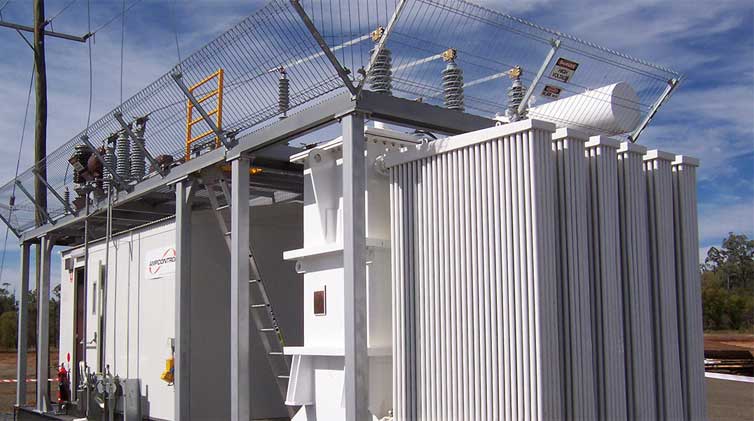Main Differences and Advantages and Disadvantages of Dry Type Transformers and Oil-immersed Power T
The construction of transformers in power engineering construction can be said to be a very important part. Among them, we often hear dry-type transformers (referred to as dry-change) and oil immersed power transformers (referred to as oil change). So what are the main differences between dry-type transformers and oil immersed power transformers in power engineering construction? What are their advantages and disadvantages?
The biggest difference between oil-immersed power transformers and dry-type transformers is "oil". Since the oil is liquid and has fluidity, the oil-impregnated power transformer must have a casing. The inside of the casing is transformer oil. The oil is immersed in the coil of the transformer. The coil of the transformer is not visible from the outside. The dry transformer does not have an outer casing without oil. It can directly see the coil of the transformer; there is also a characteristic that there is a oil pillow on the oil-impregnated power transformer, and the transformer oil is stored inside, but now the new oil-immersed transformer also has no oil pillow.
They are all power transformers, and there will be iron cores for the magnetic circuit to make the windings of the circuit. The biggest difference is in "oily" and "dry". That is to say, the cooling medium of the two is different. The former uses transformer oil (and of course other oils such as β oil) as the cooling and insulating medium, and the latter uses air or other gases such as SF6 as the cooling medium. Oil change is to place the body consisting of iron core and winding in a fuel tank filled with transformer oil. Drying often encloses the core and windings with epoxy resin. There is also a kind of non-encapsulated type that is used nowadays. The windings are impregnated with special insulating paper to prevent the windings or core from getting wet.
In order to facilitate heat dissipation, that is, for the convenience of internal insulating oil flow, a heat sink is designed outside the oil immersed power transformer, just like a heat sink. The dry type transformer does not have this radiator, and the heat is cooled by the fan below the transformer coil.
Oil immersed power transformers are typically installed indoors or outdoors in separate transformers for fire protection purposes. The dry type transformer is definitely installed indoors and is usually installed in the power distribution room.
In terms of output and dosage, the current dry voltage level is only 35kV. Its capacity is small compared to oil change, about 2500kVA. Moreover, because the manufacturing process of dry-type transformers is more complicated and costly than oil transformers of the same voltage level and capacity, the oil transformer is still more in terms of the amount of oil. However, due to the environmental protection of dry change, flame retardant, impact resistance and other advantages, it is often used indoor and other high-demand power supply and distribution sites, such as hotels, office buildings, high-rise buildings and so on.
It can be seen that the dry transformer and the oil transformer each have their own advantages and disadvantages. The oil transformer is low in cost and easy to maintain, but it is flammable and explosive. Dry transformers can be installed in the center of the load due to their good fire resistance to reduce voltage loss and power loss. However, dry transformers are expensive, bulky, moisture-proof and dust-proof, and have high noise.
Next, let's summarize the differences mentioned above into the following seven points:
1. Appearance
The two packages are different. The dry transformer can directly see the iron core and the coil, while the oil-impregnated power transformer can only see the outer casing of the transformer;
2. Different lead forms
Most of dry-type transformers use silicone rubber bushing, while most of oil impregnated power transformers use porcelain bushing;
3. Different capacity and voltage
Dry type transformer is generally suitable for power distribution, with capacity mostly below 2000kVA and voltage of 10kV and below, and some of them can achieve 35kV voltage level; while oil immersed power transformer can achieve all the required capacity and voltage level can also achieve all the voltages; for the UHV 1000kV line under construction in China, oil immersed power transformer must be used.
4. Insulation and heat dissipation are different
Dry-type transformers are generally insulated with resin, relying on natural air-cooling, and large-capacity cooling by fans; while oil-impregnated power transformers are insulated by insulating oil, and the inner coil of the transformer is recycled by insulating oil inside the transformer to dissipate heat.
5. Applicable places
Dry type transformers are mostly used in places where "fire prevention and explosion-proof" are required, and should be used in general large buildings and high-rise buildings; oil impregnated power transformers are mostly used in outdoor places where "accident oil pool" is dug due to oil gushing or leaking after "accident".
6. Different load bearing capacity
Generally, dry-type transformer should operate at rated capacity, while oil immersed power transformer has better overload capacity.
7. Different cost
For the same capacity transformer, the purchase price of dry-type transformer is much higher than that of oil immersed power transformer.
Jump to Content Sections
Leave a Message
You May Also Like
 English
English  français
français  Español
Español  русский
русский  العربية
العربية  tiếng việt
tiếng việt  Malay
Malay  Indonesia
Indonesia  বাঙালি
বাঙালি 

